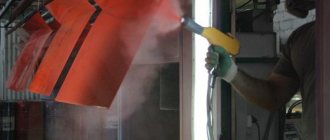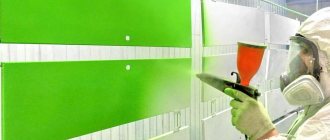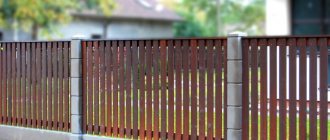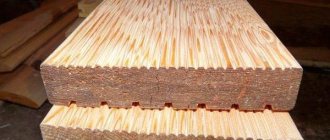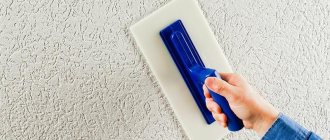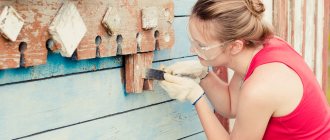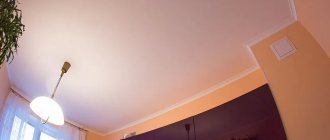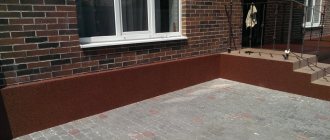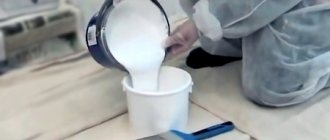Protecting the base is a mandatory measure that allows you to protect the foundation of the house from the negative effects of moisture and extend its service life. This requires high-quality waterproofing and reliable finishing. A cost-effective and simple option is to paint the base part. The abundance of paint and varnish compositions on the market allows you to choose the most suitable type of paint for any situation.
Reliable protection of the base part
Why is it necessary to protect the foundation, plinth
Painting the base will solve a large number of problems. Timely painting using the paint most suitable for the home allows you to:
- Provide additional protection for the base. The base is affected by many unfavorable factors. Treatment of the porous surface gives it additional strength and resistance to external influences. In addition, this finish is very easy to update.
- Create an additional protective layer that will retain moisture while allowing vapor to escape. This will significantly extend the life of the house.
- Simplify the care process. The basement gets dirty much more than the rest of the building. The right choice of paint will make it possible to clean it without much effort, as well as renew it if necessary.
- Hide minor defects and make the appearance of the house attractive. By using a combination of different shades on the base and facade, you can realize bold design ideas.
The base part will last for many years
A significant advantage of painting the base is the cost-effectiveness of such finishing. The cost of the paint is quite reasonable, and it will take a maximum of a day to complete all the work.
The importance and necessity of finishing the base
Painting the base improves its appearance and protects it from external influences.
Painting the base allows you to solve several important issues, but you need to choose the composition taking into account climatic conditions and operating characteristics. It is also important to understand why this procedure is needed:
- Many materials that are used to build a foundation have a porous structure, so moisture can penetrate inside, destroying the structure.
- Concrete or brick is subject to mechanical stress. The paint protects the base from damage.
- The above-ground part of the foundation is subject to rapid contamination, which worsens its appearance. Painting the surface will make it easier to maintain.
A concrete structure without proper finishing does not look very aesthetically pleasing. Paint treatment allows you to achieve a decorative effect: the base will look neater, and minor construction defects will not be visible.
Performance requirements for paints
When determining how to paint the base of a house, it is worth carefully studying all the characteristics of paint and varnish materials, since higher demands are placed on the base part. Thus, high-quality facade paint has the following characteristics:
- Waterproof. The materials must have a high coefficient of water repellency, as this will protect the painted base, and therefore the foundation.
- Vapor permeability. The removal of internal vapors to the outside is a very important nuance, which allows you to ensure a comfortable microclimate in the room.
- Fire resistance. An important parameter, especially for those buildings where there are increased fire safety requirements, as well as those where metal or corrugated sheet metal finishing was used.
- Resistance to temperature changes. Essential, since paints for exterior use must be resistant to the negative effects of external factors. This will allow the paint to last longer without cracking.
- Resistant to sunlight. Ultraviolet radiation negatively affects the color saturation of the base. Durable paint will retain its attractiveness longer.
- Wide choice of shades. Modern owners of private houses have special requirements for the appearance of coatings and finishes, so the abundance of colors will allow you to choose the option that best matches the rest of the facade elements.
Modern paint manufacturers use various raw materials for production. Certain types are suitable for different types of surface. Correctly selected composition for painting is a guarantee of high-quality protection and aesthetic appearance.
Description and types of paints for the base
Paints and varnishes are so diverse in their composition that it is almost impossible for the average person to understand them. There is a lot of information on the sites, it is sometimes contradictory, and often completely untrue. Armed with a chemist's reference book, we will try to give our readers more reliable information.
- By and large, all coatings can be divided into 2 large groups: 1) water-based (also known as aqueous emulsions and dispersions); 2) on solvents of organic origin.
- In water-based emulsions, the role of a binder is played by polymer particles (acrylics, styrene), which, when diluted with water, form an emulsion. In organic paints, the binders are alkyd resins, and accordingly the paints are called alkyd.
- Modern chemistry has advanced a lot. Manufacturers create combined compositions that contain both polymers and alkyd substances, which allows them to preserve the advantages of both.
In particular, water-based paints are not only more environmentally friendly, but they dry faster and do not have a toxic odor. These disadvantages are present in alkyd paints, but they form a more durable coating, are easier to clean from dirt, last longer and are cheaper.
Aqueous dispersions
A dispersion is a liquid mixture of components that cannot dissolve in each other. In the names on the label of paints you can see the terms “water-dispersed” or “water-emulsion”. They only talk about the method of manufacturing paintwork materials with certain technological differences, but this does not affect the characteristics of the paint or the film it forms. This category includes acrylic, silicone, silicate and latex paints, the characteristics of which depend only on the properties of the polymers used or their composition (for example, acrylate).
Latex and acrylate paints
Previously, latex was called aqueous dispersions of any polymers; today this term refers only to elastic materials made from rubber. However, the paint called latex is not the most flexible. It can generally be made on the basis of different polymers. One paint can contain a dozen ingredients, and not all of them will be latex. What matters here are the specific strength characteristics of the coating, which are obtained, for example, on the basis of styrene-acrylic. Often such paints are called acrylate.
In addition to the binder, dispersion coatings contain antifreeze, emulsifiers, corrosion inhibitors, thickeners, and dispersants. Such paints are fireproof and non-toxic, and what’s most valuable is that they can be applied to wet surfaces. When applied to the outer surface of the base, which is subjected not only to moisture, but also to mechanical stress, acrylate paints have a drawback - low coating hardness. It lasts up to 7 years. This is a good indicator for paint, but compared to many other facade materials, the period is not too long.
Alkyd paint and varnish compositions
The starting material for the manufacture of these paints is polyester resins. These are products of the synthesis of polybasic acids with complex alcohols, which is called alkyd (from the word “alcohol”). The price of alkyd-based paints is determined by the type of film former used - glyphthalic or pentaphthalic. The latter allows you to get the most optimal combination of price and quality of paint, which creates a more durable film with excellent mechanical properties.
Expert opinion Vitaly Kudryashov builder, aspiring author
Ask a Question
Paints based on glyphthalic alkyds dry faster, but are less resistant to weathering, so it is better not to use them for outdoor work.
Polyesters are modified with fatty acids obtained from natural or synthetic oils, as well as vegetable oils, which allows the use of paints at low temperatures. The coatings last a long time, do not turn yellow and do not lose their gloss, which is their positive quality.
As already mentioned, an alkyd base can be combined with a polymer one, so you can see alkyd-acrylic, melamine-alkyd, phenolic-alkyd, urea and alkyd-urethane paints on sale. It is the polymers that are the modifying elements here, which provide higher adhesive strength, droplet adhesion rate, spreadability over the surface and other characteristics of paintwork materials.
The advantages of alkyd paints include:
- high weather resistance;
- durability;
- excellent adhesion;
- crack resistance;
- versatility of use;
- high hiding power;
- consistency convenient for painting;
- low cost;
For ease of application on uneven terrain, alkyd paints are also sold in aerosol packaging.
Epoxy paints
Epoxy coatings may or may not contain organic solvents - or, like dispersion options, be water-soluble. The only difference between them is that they cure at different temperatures and due to different modifying epoxy resins.
Paints containing organic solvents cure cold and usually contain a second component - a hardener. The first component is a semi-finished varnish or enamel, with the addition of a solvent, filler and pigment.
Water-soluble epoxy paints are one-component, hot-curing. They contain epoxy resin, a modified solvent, pigments and additives that accelerate curing, which begin to work when the paint interacts with air. Their production uses high-molecular resins with a high melting point, which, when interacting with the components of the hydroxyl group, form a coating with a network structure.
Epoxy paints adhere well to mineral substrates, and the coatings have excellent water resistance, making them ideal for painting bases.
Polyurethane coloring compounds
It is not easy to concentrate all the requirements for facade coatings in one product; each option has not only advantages, but also disadvantages. Polyurethane-based coatings have one of the best combinations of durability, environmental friendliness, quality and price, which is why they are used in almost all areas of construction. Their range is constantly expanding, and although the production volume is inferior to the same water-dispersed materials, the growth rate of consumption is only increasing.
The growing popularity of polyurethane paints is due to their high quality and resistance to:
- atmospheric influences;
- water permeability;
- chemicals;
- abrasive;
- high and low temperatures.
These paints have excellent adhesion strength to any substrate, they are environmentally friendly, dry quickly, and the coating has an excellent appearance. The only drawback is the relatively high cost, but given the service life of the coating up to 20 years, it is completely justified.
Polyurethane-based coatings can be divided into 4 groups:
- A two-pack system that cures at normal temperature and air humidity.
- Cures with slight heating.
- Hot drying paints (temperature not less than +100 degrees).
- Physically dried polyurethane compounds (can be used at sub-zero temperatures).
- Compositions based on modified polyurethanes, oxidative drying.
The best choice for painting foundations are polyurethane enamels with 100% dry residue, which form coatings with excellent water and frost resistance. They can be stored for a long time, and when exposed to air or moisture, they quickly cure and form a strong, durable coating.
Let's look at the properties of paints for concrete
The paint for the base must be of high quality and resistant to external factors. It must be applied over a primer, which improves the adhesion of the composition to the base. It is better to purchase primer and paints at the same time, if possible from the same manufacturer.
Acrylic paints
Paints made on the basis of acrylic resins are considered one of the most common.
This is thanks to their easy application and fast drying time. These materials have virtually no odor and do not have a harmful effect on humans. With their help, it is possible to create a durable film that repels moisture from the surface. To increase the strength characteristics, marble chips can be added to the mixture. These compositions are produced mainly in white. To give the required shade you need to use a special colorant. One of the varieties of acrylic paints is acrylate. It is similar in properties, but differs in its composition. A well-known brand of such material is Tikkurila Yuki.
Silicone paints
Compositions based on silicone resins are ideal for painting plinths finished with plaster.
With the help of such paint, it is possible to create a durable outer layer that can repel moisture from the outside and allow vapor to pass through from the inside. Due to the high degree of elasticity, no additional surface tension is created, which significantly extends the life of the paint. In addition, it perfectly withstands the influence of ultraviolet radiation, without fading and maintaining its attractiveness.
Epoxy paint
Mixtures containing epoxy resins are considered one of the most durable.
This is achieved by introducing a special hardener into the paint, which is added to the composition immediately before application. The cost of this type is quite high, but with the help of this material it is possible to protect the base not only from atmospheric influences, but also from mechanical damage.
Polyurethane paint
Modified paint with the addition of polyurethane is durable and attractive in appearance. With its help, you can give the surface a certain texture, which increases its aesthetic qualities. But the price of such paint and varnish material is more expensive than other options. Polyurethane paint creates an excellent protective layer, protecting the surface from chemical, mechanical and atmospheric influences. The composition penetrates deeply into the base and clogs microcracks and pores.
To achieve maximum durability, it is necessary to apply the paint in two layers. The second one needs to cover the surface after the first one has dried. Within a week the base will gain mechanical strength, and after two weeks it will become resistant to aggressive influences.
Silicate
To paint surfaces made of mineral materials, compositions based on liquid glass are used. Of all the paints, silicate is the most commonly used for painting bases. This is due to its excellent quality characteristics: resistance to mechanical and chemical stress, the influence of precipitation - combined with an affordable price.
However, there are also disadvantages to silicate paints. Among the main ones are a long drying period and a low coefficient of vapor permeability.
Alkyd
Unlike silicate paints, alkyd compounds are used for painting wooden and metal surfaces. They have good protective properties, minimize the influence of moisture and aggressive substances, which makes it possible to clean the base using chemical compounds.
Despite the high resistance to ultraviolet radiation, it is necessary to periodically renew the surface. This should be done approximately once every three years.
Oily
Like all other types of paint
, compositions based on drying oil are strong and durable.
The material dries within 24 hours, creating a protective film on the surface. This paint has a very attractive appearance and is consumed very economically, while the cost of such a paint coating is quite reasonable, which makes it not only reliable, but also profitable.
Cement
This type of paint is made from cement with the addition of coloring pigments, as well as lime. They are not suitable for painting wood and metal. But for concrete, brick and plastered surfaces, this is a very profitable option, since the composition allows you to create a durable protective coating that not only prevents the penetration of moisture, but also perfectly complements the exterior due to its aesthetic appearance.
Any of the listed paint and varnish materials can make the base attractive, while providing it with additional protection from the influence of external factors. But this is only possible if the application technology is followed.
Why do you need to paint the foundation base?
Any stone, whether natural or artificial, has pores in its structure, and the lower the density, the more. Through these pores it absorbs moisture, in which various salts (bicarbonates, sulfates, chlorides) can be dissolved, and even rainwater is an alkaline solution. Apart from the ice formed during the freezing process, it is the salts that have a destructive effect on a concrete or brick structure, crystallizing and increasing in volume.
The base is in direct contact with the ground, so it is affected not only by rain moisture, but also by groundwater - after all, cases when groundwater seeps to the surface are not at all rare. Under such conditions, the body of the base begins to become damp, be it masonry or a concrete monolith, which entails the following consequences:
- carbonization of concrete - the formation of calcium carbonate, which negatively affects the reinforcement;
- efflorescence - the release of salts contained in moisture onto the surface (mainly appear on brickwork);
- mold forms;
- the protective layer of concrete is destroyed.
Therefore, even if the facade itself is left unfinished, the base part must be protected with at least such a simple coating as paint.
Advantages and disadvantages
Painting the base has the following advantages and disadvantages:
| Plus | Minus |
| Low thickness and weight of the coating. | If it is necessary to insulate the base, in addition to installing thermal insulation, you will have to install a reinforced plaster layer, and this will greatly increase the cost of finishing. |
| Waterproof. | Low level of decorativeness of the coating, if you do not use textured plaster. |
| Resistance to ultraviolet radiation and temperature changes. | The service life is no more than 10 years, and even then it depends on the paint. |
| A huge range of colors, there is the possibility of tinting. | |
| Low price compared to other coatings. |
The best paint for the base: expert advice
Professionals say that paint for the base and foundation should be selected taking into account a lot of nuances:
- the material from which the base is made;
- climate features of the region;
- operating conditions of the building;
- life time;
- dyeing technology;
- price;
- desired color.
In some situations, it is advisable to use more expensive compounds that can withstand sudden temperature changes. For others, you can choose economical options.
In any case, it is worth familiarizing yourself with the composition of the paint, checking the expiration date and purchasing a primer that will help ensure a high level of adhesion of the materials.
Instructions for painting the base
The procedure for applying and drying paintwork depends on what kind of foundation paint was used, but the general sequence of actions is always approximately the same. The work begins, of course, with the selection of tools.
What tools are needed to paint the foundation?
There are quite a few types of painting tools, and each option is designed to solve a different problem. Hand tools are brushes and rollers, which are divided into subtypes according to the material from which the working part is made. Brushes have bristles, rollers have fur.
- For alkyd paints, you need to take brushes with natural bristles, since artificial ones can be corroded by the solvents contained in the paintwork materials. For water-based paints, on the contrary, brushes with artificial bristles are better suited, as they do not absorb water like natural ones, which can increase consumption.
- Working with a brush moves slowly, the coating is not so uniform and may have streaks. However, it can be used to paint a relief surface and better cover internal corners or surfaces of complex configurations.
- To paint straight areas of a large area, it is convenient to use a brush (flat) or a fly (round) brush with a bristle length of 100-180 mm. For small parts and corners, use a handbrist with a diameter of 25-50 mm and bristles up to 60 mm.
- Rollers are also available in different shapes and sizes, and can have not only different diameters and widths of the working part, but also handle lengths. The length of the pile can also be different: the shorter it is, the lower the paint consumption, but sometimes it needs to be increased (for example, when painting embossed plaster).
- Roller coats are made from a variety of materials. Microfiber and foam rubber are good for applying primer; fur coats - for alkyd paints; nylon is suitable for epoxy and polyurethane paints; Polyamide acrylic and polyester coats are ideal for water-based paints.
Expert opinion Vitaly Kudryashov builder, aspiring author
Ask a Question
Before use, new rollers and brushes should be washed with soap and dried so that fallen lint and bristles do not stick to the paintwork and spoil its appearance.
Cleaning, filling cracks and leveling the surface
Painting work is an entire art, and in order to get a high-quality coating, you need to keep in mind many nuances and know a lot of professional tricks. Preparation of the base is especially important, and here are the stages it consists of:
- The base is cleaned of old coatings, dust, solution build-up, rust and oil stains.
- Uneven bases need to be leveled, for which a basic plaster composition (with a coarse filler fraction) is used.
- The second layer is puttying, due to which smaller errors are eliminated. The surface becomes smoother, which reduces paint consumption.
Expert opinion Vitaly Kudryashov builder, aspiring authorAsk a Question
Relatively smooth basement walls can be puttyed instead of plastered.
- To reduce the absorption of the base, priming is performed before applying paint, which will improve the adhesion of layers, reduce paint consumption and improve the appearance of the coating.
Painting the foundation - probable defects and causes of their occurrence
When carrying out external work, a number of coating defects may appear. Let's consider what could be the reasons for such manifestations:
- The coating has lost its shine. Perhaps it did not have time to dry before dew fell or rain began to fall.
- The paint film has bulged or cracked (detached from the base). The reasons may be: the surface is poorly cleaned; the base is too hot in the sun; the second layer was applied over the undried first; paint is applied to a wet base.
- The appearance of efflorescence on the painted surface. The paint is applied to a base that has not been cleaned of efflorescence; priming has not been done; the foundation actively absorbs water from the ground.
- Wrinkling of the decorative coating. Reasons: increased humidity of the base; poor-quality interlayer drying, poor preliminary cleaning of the base. If painting is done over an old coating, the cause may be chemical incompatibility of the paints.
- The appearance of stripes on the painted surface and different colors. The temperature and humidity of the substrate is too high, at which the paint dries too quickly. The reason may be excessively diluted paint, lack of a primer layer, thick unshaded layers of paint, or the use of low-quality tools; painting in hot weather under direct sunlight.
Primers for outdoor work
The primer is selected taking into account the characteristics of the material from which the surface is made. Professionals recommend purchasing materials from one manufacturer. This guarantees their full compatibility and achievement of the best results. Also, when choosing soil, you should take into account the geographical and climatic characteristics of the region.
The surface must be primed several times: before filling cracks and immediately before painting. If the base is problematic, then you can use quartz soil to strengthen the surface. It has inclusions of quartz sand and helps seal cracks and prevent efflorescence.
For buildings located in cities, it is recommended to use acrylic primer, which is breathable. This primer is also suitable for rural areas. In addition, silicone-based primer can be used for country houses.
What tools are needed to paint the basement of a house?
Painting the base is a fairly simple process. It does not require any special devices. For staining you need to prepare:
- spray gun, roller and brushes for applying paint;
- container for diluting paint and varnish composition;
- container with water;
- hard bristle brush;
- hammer and chisel to remove irregularities.
You may also need additional devices that will be used to prepare the base.
Technology for painting the base
When paint for facades and plinths has been selected, you should study the features of its application. Manufacturers usually indicate the characteristics of coloring using the composition. But there is also a general technology for applying paint to the surface.
Surface cleaning
First of all, you need to prepare the surface for painting. To do this, it is worth removing protruding remains of concrete or loose bricks. For this purpose, you can use a stiff brush or spatula. For large defects it is worth using a hammer and chisel. It is important to thoroughly clean the base so that the paint adheres evenly to the base.
Sealing cracks and leveling the surface
After thorough cleaning, the cracks should be repaired and the base leveled. To do this, the surface is first coated with primer, which will help plug the cracks and ensure strong adhesion of the mixture to the surface. All defects are treated with a mixture of cement and sand.
Sealing cracks
If you need to create a more durable solution, you can add a plasticizer to it. 2 days after embedding, they begin leveling the base. Further procedures are carried out after the solution has completely dried.
Surface primer
The primer is applied to a dry surface. It is important to coat the plinth thoroughly so that the compound penetrates into every crevice. This guarantees perfect paint adhesion. You can cover the wall with two layers of primer.
Primer work
This is due to the fact that after the first application the primer is almost completely absorbed by the base. You can coat the base with a primer using a brush or roller.
Painting the base
Painting the base of the house is carried out in several passes. You can apply two or three layers. This will achieve the perfect color and provide maximum protection. It is best to paint the surface using a sprayer, but if it is not available, you can use brushes of various widths or a roller.
Final coloring
Each subsequent layer is applied after the previous one has dried. Typically, the time when the base can be coated with the next layer is indicated by the manufacturer.
A painted base is not only beautiful, but also reliable. Correctly selected composition and adherence to the technology of its application will help prevent damage to the surface from the influence of external factors.
In addition, a large abundance of paints and varnishes makes it possible to embody original design ideas, where the base will become an integral element of the overall picture of the facade.
There is a simple and effective remedy - base paint, to protect and decorate the top of the base.
- Concrete and brick used for construction have a fairly porous structure. Moisture, temperature changes, mechanical stress and aggressive environments can destroy the material quite quickly. To close the pores from penetration, not only impregnation and primer , but also painting the base of the house.
- A properly selected paint coating will allow steam to penetrate, but will not allow moisture into the material. Thus, the foundation will “breathe” and not become damp.
- The lower part of the building is polluted more often and more heavily than the walls. Maintenance can be reduced to a minimum by painting the base. How to beautifully paint the outside of a house using plaster photos? The process is simple, you can completely do it yourself, taking a day off to work.
- The aesthetic side of the issue is of no small importance. The house will immediately change for the better, imperfections will no longer be noticeable. The building will become more respectable and neat.
